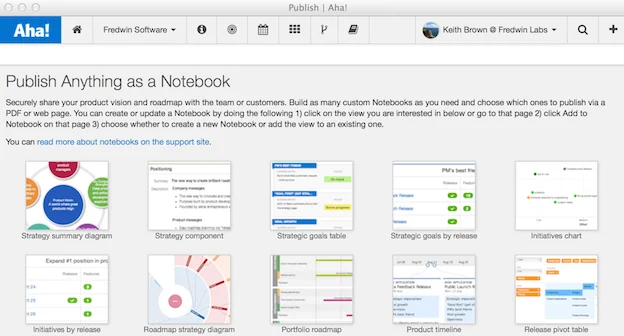
Securely Share Your Visual Product Roadmap
Did someone ask you for your product roadmap today? Or request a delivery date for that game-changing new feature?
Sharing your product roadmap with internal colleagues who liaise with customers is part of the job. Your roadmap contains the specific details behind your features and when you plan to deliver them in the coming months.
Before we introduced Aha! Notebooks, it was almost impossible to maintain your roadmap. You probably spent countless hours each month preparing the perfect roadmap views for meetings with internal stakeholders, partners, and customers.
That’s why Aha! Notebooks are terrific. You can create as many as you need and take nearly any view you’ve already built in Aha! to quickly share it via a PDF or a secure web page. You can lock them down via a passcode and by limiting access to only your approved users of Aha!
Proudly and securely share your brilliant strategy and product roadmap with ease — and keep it up-to-date with the click of a button.
It’s easy to create your first Notebook. It can include your strategy, a release timeframe, and key features. You can have as many Notebooks as you want to present different information to different audiences. And when the time is ready, you can share a Notebook as a PDF document or via a secure URL as a web page.
Here’s how it works
Publish a Notebook It’s easy to start publishing your brilliant roadmap. Use the top level navigational tab titled Notebooks. It’s the last tab on the right. Click on this tab, then click the Add Notebook button in the lower right-hand corner of the screen. This will create a new Notebook for you to start working on. It will also automatically take you to the editing screen where you can work on your new Notebook.
Customize your title screen and views The next step is to add a title, sub title, and description to your Notebook. After customizing your title screens, add the specific views that you want to tell your story. For example, start with your strategy summary diagram, move on to the releases view, and then include the key features. You can also custom brand your Notebooks if you would like to add your own logo to both the PDF and web Notebooks.
Add other users to collaborate You may also want to collaborate on a Notebook with someone else from your team. You can do this by clicking the (+) sign next to the list of Collaborators on the left side of the page. Use the drop-down menu to quickly add team members whom you want to work with. Each collaborator can see every view that has been added to the Notebook, and they can add views to the Notebook as well.
Set permissions and visibility You can allow Notebooks to be locked down via a passcode and/or only allow access from registered Aha! users. This is an account level setting, and can only be set by administrators. When Notebooks are restricted to the Aha! account only, you can allow further control per Notebook. This means that the Notebook will only be visible to users of the specified products.
Share your Notebook When you are ready to publish a Notebook, you can save it as a PDF or create a Web page. When you create a Web page, a secure link is generated (this link is not indexed by search engines). You can then share that link as desired with the proper stakeholders.
If you update a Notebook after publishing it, you can create new PDFs. You can also download the old versions that were created (on the left of the screen). For web pages, please note that there is always only one URL per Notebook. While you can view older versions that were created (on the left of the screen), you cannot revert to an older Web page and publish it.
Notebooks are your chance to be known for customizing your roadmaps. Everyone wants to see information “their” way. Now, you can present it in as many views as you need — without any extra burden.
Signup for a free Aha! trial — be happy Notebooks are available to all Aha! customers. If you are not already one of them, sign up for a free 30 day trial of Aha! to see why over 10,000 users trust us to set product strategy, create visual roadmaps, and prioritize releases and features.





